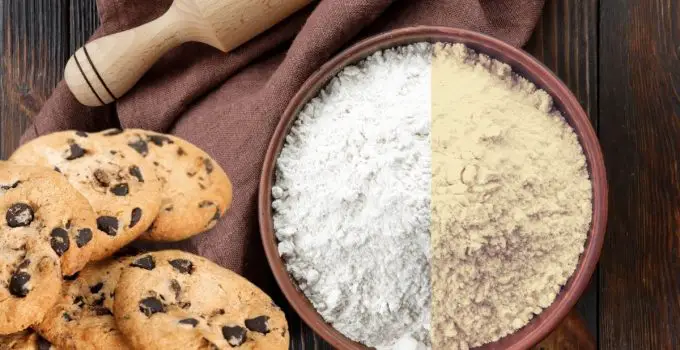Imagine you just got your hands on your granny’s famous homemade chocolate chip cookie recipe. You look at the ingredients list, and there, at the very top, you see the enigmatic word flour. The question is – what kind of flour?
The straightforward answer would be all-purpose flour. But even that simple answer is followed by another vital question. Should you use bleached or unbleached all-purpose flour? And that’s how you ended up here.
Did we guess it right? However you ended up reading these words, what matters is that you’re here, looking for an answer to your mind-boggling question.
Bleached or unbleached flour for cookies? Let’s establish once and for all which one to choose for baking!
Bleached flour is whiter and has a softer texture. It produces fluffy baked goods, making it a good match for cookies, pie crusts, and pancakes. Unbleached flour is less white and has a denser consistency. It tends to be best for baked goods that require structure, like yeast breads, eclairs, and pastries.

What Is Bleached Flour?
Bleached flour is a type of flour that has been treated with chemicals to speed up the process of aging, giving flour a whiter (bleached) look and a finer texture.
This process involves exposing the flour to chlorine, benzoyl peroxide, or nitrogen dioxide. These chemicals break down the carotenoid pigments in the flour, which are responsible for its natural yellow color. Once these pigments have been broken down, the flour appears whiter and more refined.
So yes, that shiny-white flour you see on most supermarket shelves is the bleached type. This is also the flour that most recipes have in mind when they mention all-purpose flour.
That’s mainly because bleached flour produces a lighter, fluffier texture in baked goods due to its finer texture.
On the other hand, because it’s heavily processed, some people are concerned about the bleaching process’s impact on flour’s nutritional value. The case might also be that a person is allergic to one of the chemicals used during bleaching.
In such cases, unbleached flour can be a healthier and less-risky alternative. And speaking of unbleached flour.
Now let’s talk about substituting and swapping, the bane of every recipe developer’s existence. If the cookbook you’re baking from was published sometime between the 1940s to 2010s, it’s safe to assume the flour in the recipe, whether cake or all-purpose, is bleached. And while I’m professionally obligated to tell you to use the flour called for in the recipe, sometimes the type is not specified, or you just can’t help yourself. Here are my rules for smart swapping.
In Baking Hows, Whys, and WTFs, food editor Shilpa Uskokovic will answer your burning baking questions and share her tips and tricks for flawless sweets. Today: Bleached flour versus unbleached flour. What’s the difference?
Cookies, pie crusts, pastries and breads: You can swap freely between bleached and unbleached flour depending on what you have on hand for treats like pies, cookies, eclairs, cream puffs, puff pastry, and yeast breads. The end result will vary (cookies made with unbleached flour will spread more, for instance) but not enough to ruin a batch.Pie crust, or bust:
Most important, how does this affect your baking? Bleached flour is whiter than unbleached flour, and more acidic. The bleaching process uses bleaching agents like benzoyl peroxide or chlorine dioxide (a chlorine gas that’s also used to treat tap water) to break down the starches and proteins in flour, making it softer and more absorbent. Baked goods made with bleached flour can take on more fat and more sugar, making the final result extra tender and rich, with a softer texture. Nowhere is this more evident than cake making. In fact, boxed cake mix came into existence only after the invention of bleached flour, so essential is the process to its success.
Did you, like me, grow up with only one type of flour in the pantry to use for all the baking? My dad’s too-sweet-but-still-good apple crisp, my experimental cookies, and the rare lemon drizzle cake from my mother were all made with the same flour, from the same bag with the red lettering, and that was that.
Should You Use Bleached Or Unbleached Flour For Cookies?
FAQ
Does unbleached flour affect cookies?
Which type of flour is best for cookies?
When not to use unbleached flour?
Which is better bleached or unbleached all-purpose flour?
Can you use Unbleached flour for cookies?
Bleached flour works better for cookies, pancakes, waffles, cakes, quick bread, and pie crusts. Unbleached flour works better for puff pastries, eclairs, yeast bread, and popovers. Bleached flour is treated with chemicals to speed up the aging process and unbleached flour is naturally aged after milling.
What can be used instead of white flour?
Instead of white flour, you can use whole wheat flour, add oats to the flour, or add seeds. You have to take into account that some recipes need white flour.
Should I use bleached or unbleached flour for chocolate chip cookies?
For example, if you prefer your chocolate chip cookies soft and tender, bleached flour is a better choice. However, unbleached flour will provide better results if you’re going for a more crispy cookie experience with a rich taste. Also, if you have more strict nutritional requirements, we’d recommend using unbleached flour.
Can you use unbleached or bleached flour in baking?
It is, however, denser in texture, which provides more structure to your cookies, making it a preferred flour option among crispy cookie lovers. Overall, both bleached and unbleached flour can be used in baking, and it’s up to you to decide which type of flour will work best for your specific recipe and taste preferences.
